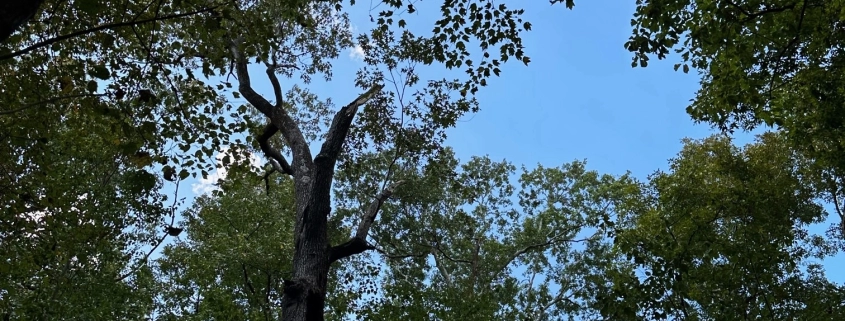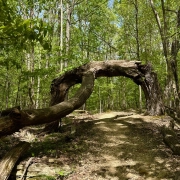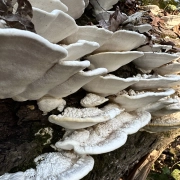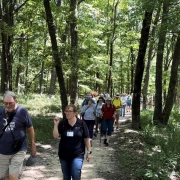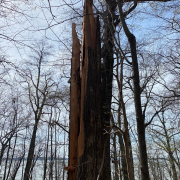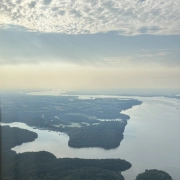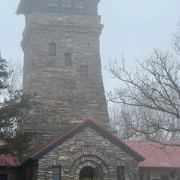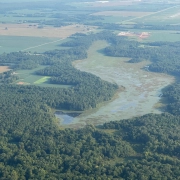An Aging Riparian Hardwood Forest on The Wheeler National Wildlife Refuge
Late afternoon on September 22, 2023, I decided for the first time since my June 19, 2023 triple bypass surgery to bushwhack alone into my favorite riparian hardwood forest at the nearby Wheeler National Wildlife Refuge. I’m a student of this forest, attempting with each visit to learn more about its history, composition, dynamics, and future. I employ a woods-wandering technique I call sauntering. I borrow the term from John Muir and a contemporary of his, Albert W. Palmer, who published A Parable of Sauntering in 1911:
There is a fourth lesson of the trail. It is one which John Muir taught me [during an early Sierra Club outing].
There are always some people in the mountains who are known as “hikers.” They rush over the trail at high speed and take great delight in being the first to reach camp and in covering the greatest number of miles in the least possible time, they measure the trail in terms of speed and distance.
One day as I was resting in the shade Mr. Muir overtook me on the trail and began to chat in that friendly way in which he delights to talk with everyone he meets. I said to him: “Mr. Muir, someone told me you did not approve of the word ‘hike.’ Is that so?” His blue eyes flashed, and with his Scotch accent he replied: “I don’t like either the word or the thing. People ought to saunter in the mountains – not hike!
“Do you know the origin of that word ‘saunter?’ It’s a beautiful word. Away back in the Middle Ages people used to go on pilgrimages to the Holy Land, and when people in the villages through which they passed asked where they were going, they would reply, “A la sainte terre,’ ‘To the Holy Land.’ And so they became known as sainte-terre-ers or saunterers. Now these mountains are our Holy Land, and we ought to saunter through them reverently, not ‘hike’ through them.”
John Muir lived up to his doctrine. He was usually the last man to reach camp. He never hurried. He stopped to get acquainted with individual trees along the way. He would hail people passing by and make them get down on hands and knees if necessary to see the beauty of some little bed of almost microscopic flowers. Usually he appeared at camp with some new flowers in his hat and a little piece of fir bough in his buttonhole.
Now, whether the derivation of saunter Muir gave me is scientific or fanciful, is there not in it another parable? There are people who “hike” through life. They measure life in terms of money and amusement; they rush along the trail of life feverishly seeking to make a dollar or gratify an appetite. How much better to “saunter” along this trail of life, to measure it in terms of beauty and love and friendship! How much finer to take time to know and understand the men and women along the way, to stop a while and let the beauty of the sunset possess the soul, to listen to what the trees are saying and the songs of the birds, and to gather the fragrant little flowers that bloom all along the trail of life for those who have eyes to see!
I shall remain a dedicated saunterer from this day forward. My weathered knees no longer allow serious hiking. I insist on walking in the woods rather than walking through the forest. I also embrace Muir’s wisdom about experiencing life: The world’s big and I want to have a good look at it before it gets dark.
HGH Road Riparian Hardwood Forest
Saunter with me as I transit the riparian hardwood forest south of HGH Road on a mid-September afternoon. I’ll begin with a 39-second, 360 degree sweep within the mature forest. Note that my narrative refers to the sweep as 380 degrees…the price I pay for accepting a first take without review. I’ve stopped seeking perfection in my short, unrehearsed videos. I find that a relaxed, non-scripted video seldom falls short of being adequate…occasionally even good.
High quality timber does not dominate these long-unmanaged forests. This 30-inch diameter red oak is deeply decayed. Occupying nearly a tenth of an acre of crown space, the tree has no commercial timber value. However, the US Fish and Wildlife Service manages these lands and their forests for values unrelated to timber.
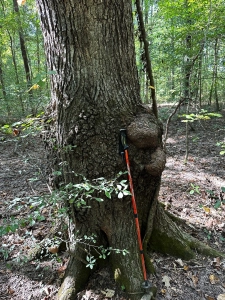
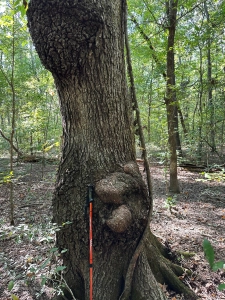
Although not contorted by decay, this hickory is hollow to the core, a perfect den tree for squirrels, woodpeckers, bats, and assorted other wildlife.
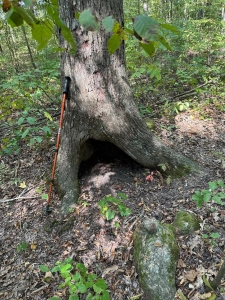
This 32-second video depicts the peace, birdsong, and soft breezes within this 90-year old stand:
Ample dead and down woody debris characterizes these 90-year-old forests growing on rich riparian soils in northern Alabama. This tree uprooted at least a decade ago, lifting a root ball wasting away at my feet, and falling directly away. The log is well on its way to becoming humus and soil organic matter,
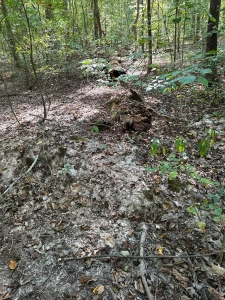
This individual did not blow over and lift a root ball; it died standing and its dead superstructure subsequently broke off at ground level, falling away from me. Little of the fallen bole remains. The carbon cycle spins rapidly in our climate! Aerobic decomposition is the rule. No future peat or coal deposits, nor even a thick organic layer in the topsoil.
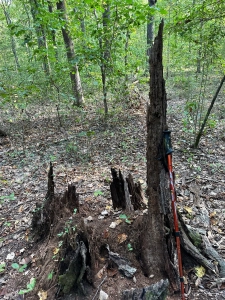
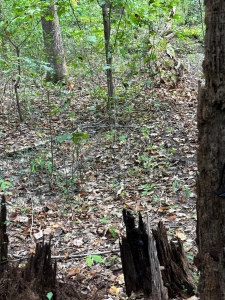
This large oak pulled up a massive root ball about ten years ago. Fine and medium roots have long since decayed. The root ball soil has fallen or washed into a shrinking and softening pile. The fallen bole, and its cracked and hollow trunk, have already shed all bark and outer wood. Although far beyond my means and technology, I’d like to see a 10-15 year time lapse as this once mighty oak dissolves (not literally, but metaphorically) from solid wood to dust to soil organic matter.
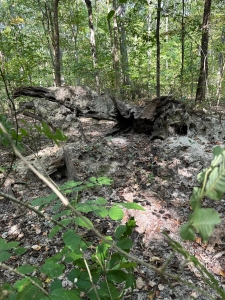
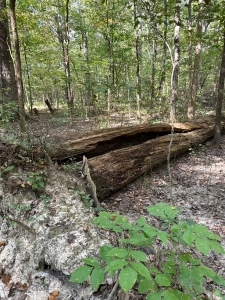
I mused about what long ago injury opened the trunk to the decay fungi that hollowed the bole. Was a lightning strike responsible for the vertical wound, shattering the trunk and creating the infection court through which fungal spores entered to begin internal decay? That isn’t the only unsolved mystery. I believe, with deeper contemplation, that the tree stood hollow with no externally visible vertical scar and split. Instead, when the tree finally yielded to gravity, its still impressive mass slammed into the ground shattering the rind, giving the impression that while vertical the tree trunk furrow permitted visual entry to its hollow core.
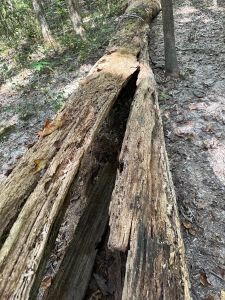
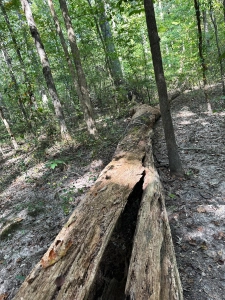
All fine branches in the crown (below left) have decayed. In fact, the crown consists only of the twin major forks. The base of the left fork evidences an opening that appears unrelated to shattering from impact. I view it as a den entry point for squirrels that inhabited the hollow tree. The fallen tree skeleton, as do all trees, stands, and forests, has a compelling story to tell. I’m glad my bushwhacking led me to its final resting place…to contemplate and decipher its tale, to examine the hints left on-site.
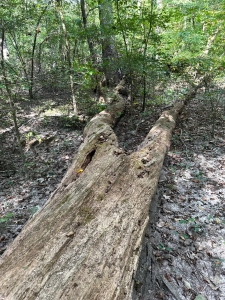
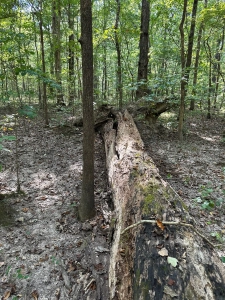
Nature provides many hints for us curious Nature enthusiasts. I relish these adventures in Nature-sleuthing. Sometimes, I celebrate when a hint leads unequivocally to a fact…a certainty. Too often, however, my conclusions fall within a zone of speculation. I’m okay with speculation, a mental process demanding deep thinking, tapping my decades of forestry study and deep woods experience, and forcing me to communicate the exercise via these Great Blue Heron photo essays. Fortunes won’t be saved or wasted as a result of my ruminations. No one is hurt if I have misjudged the circumstances that brought the tree to the ground. Many people who read these words might wonder why I don’t pursue some useful avocation…like golf, fishing, or antiquing. The truth is, Nature sleuthing is my hobby.
I’m providing hints and evidence (photos and videos) to allow you to draw your own conclusions about the nature of this mature riparian hardwood forest. I recorded this 1:15 video not far from the downed hollow oak tree I presented above.
Some standing dead trees leave a void in the crown, in this case what I estimate as a one-fifth of an acre opening. Adjacent trees are already vying for the precious sunshine, reaching inward. Forests are dynamic. The opening will be short-lived. Trees compete ruthlessly for finite site resources: sunlight, ground moisture, and soil nutrients. Nature is a meritocracy. The concepts of diversity, equity, and inclusion do not translate from faddish human social endeavors (e.g., bloated university administrative offices of Diversity, Equity, and Inclusion) to Nature. Nature’s systems operate on performance. Nature doesn’t need a DEI vice president to decide which trees adjacent to the opening are allocated what share of the newly available sunlight.
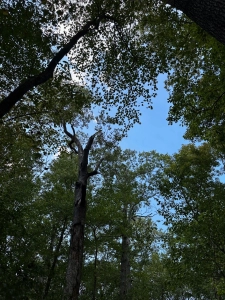
To the victor goes the spoils. Such is the way of evolutionary success.
Some portions of the forest have transitioned by way of widescale windthrow and breakage to a noticeably smaller (younger?) stand. I will continue to ponder the successional pathways within this old growth riparian forest. Watch for me to develop the pathway in future Posts.
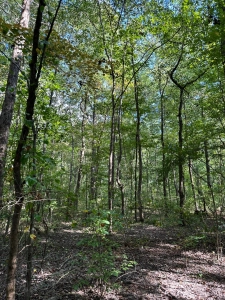
May your life be one of pleasant sauntering!
Thoughts and Reflections
I offer these observations, from Albert W. Palmer’s recollection of a conversation with John Muir:
- How much better to “saunter” along this trail of life, to measure it in terms of beauty and love and friendship!
- How much finer to take time to know and understand the men and women along the way, to stop a while and let the beauty of the sunset possess the soul.
- To listen to what the trees are saying and the songs of the birds, and to gather the fragrant little flowers that bloom all along the trail of life!
Inhale and absorb Nature’s elixir. May Nature Inspire, Inform, and Reward you!
Note: Unless otherwise noted, all blog post images are created & photographed by Stephen B. Jones. Please circulate images with photo credit: “©2023 Steve Jones, Great Blue Heron LLC. All Rights Reserved.”
Another Note: If you came to this post via a Facebook posting or by another route, please sign up now (no cost… no obligation) to receive my Blog Post email alerts: http://eepurl.com/cKLJdL
And Third: I am available for Nature-Inspired Speaking, Writing, and Consulting — contact me at steve.jones.0524@gmail.com
A reminder of my Personal and Professional Purpose, Passion, and Cause
If only more of us viewed our precious environment through the filters I employ. If only my mission and vision could be multiplied by untold orders of magnitude:
Mission: Employ writing and speaking to educate, inspire, and enable readers and listeners to understand, appreciate, and enjoy Nature… and accept and practice Earth Stewardship.
Vision:
- People of all ages will pay greater attention to and engage more regularly with Nature… and will accept and practice informed and responsible Earth Stewardship.
- They will see their relationship to our natural world with new eyes… and understand their Earth home more clearly.
Tagline/Motto: Steve (Great Blue Heron) encourages and seeks a better tomorrow through Nature-Inspired Living!
Steve’s Four Books
I wrote my books Nature Based Leadership (2016), Nature-Inspired Learning and Leading (2017), and Weaned Seals and Snowy Summits: Stories of Passion for Place and Everyday Nature (2019; co-authored with Dr. Jennifer Wilhoit) to encourage all citizens to recognize and appreciate that every lesson for living, learning, serving, and leading is either written indelibly in or is powerfully inspired by Nature.
I began writing books and Posts for several reasons:
- I love sauntering and exploring Nature
- I see images I want to (and do) capture with my trusty iPhone camera
- I enjoy explaining those images — an educator at heart
- I don’t play golf!
- I do love writing — it’s the hobby I never needed when my career consumed me
- Judy suggested my writing is in large measure my legacy to our two kids, our five grandkids, and all the unborn generations beyond
- And finally, perhaps my books and Blogs could reach beyond family and touch a few other lives… sow some seeds for the future


All three of my books (Nature Based Leadership; Nature-Inspired Learning and Leading; Weaned Seals and Snowy Summits) present compilations of personal experiences expressing my (and co-author Dr. Wilhoit for Weaned Seals and Snowy Summits) deep passion for Nature. All three books offer observations and reflections on my relationship with the natural world… and the broader implications for society. Order any from your local indie bookstore, or find them on IndieBound or other online sources such as Amazon and LifeRich.
I now have a fourth book, published by Dutton Land and Cattle Company, Dutton Land & Cattle: A Land Legacy Story. Available for purchase directly from me. Watch for details in a future Post.

